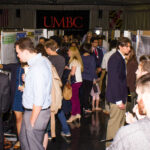
UMBC’s Undergraduate Research Symposium for the Chemical and Biological Sciences has become a destination for young researchers across the Eastern Seaboard, and it’s still growing. This year’s 20th running of the event was the largest yet, with 307 students from 47 institutions presenting 245 distinct research projects to 54 faculty judges, on topics from ecology to molecular biology to inorganic chemistry.
Nearly 100 UMBC students participated in the flagship event, which offers a rare opportunity for undergraduates to gather in large numbers to discuss their work with one another and practice presenting their findings to a wide range of people.
UMBC President Freeman Hrabowski described UMBC’s culture in his morning address, emphasizing the importance of persistence. “Success is about grit—the determination to never never never give up,” he said. “It’s that passion for continuing to learn.”
At UMBC, he continued, which welcomes students from more than 100 countries, “we are interested in making the point to America through you and others that science is exciting, that anyone who is willing to put in the effort can do it, and that you can never ask enough questions.”
Those questions can lead to important answers that impact the lives of others. “The nobility of scientific research is that you work on problems to help people you may never see. Something about that gives me goosebumps,” Hrabowski shared, adding, “What you are doing will save humankind.”
That includes research by students like Emily Bush, from Elmira College in Elmira, New York. She’s studying the effects of eugenol, an oily substance extractable from various herbs, on cancer cells. The scientist who judged her poster conducts research on the same cell lines, so Bush is heading home armed with useful feedback, inspired to “go back to the lab and really get some results and draw conclusions.”
Myra Dickey, of Salisbury University in Maryland, studied endangered spotted turtles in her research. By examining their DNA, she found that both sexes tend to disperse from their birthplace, which reduces the risk of inbreeding, but populations are so small and isolated that inbreeding’s detrimental effects are still a major concern. That means habitat conservation for the turtles is critical to their long-term survival.
Steven Lawrence and Moises Ridriguez, students at Medgar Evers College in Brooklyn, New York, presented research they conducted through the Research Initiative for Scientific Enhancement (RISE) program at Columbia University and New York University, respectively. Lawrence learned new coding skills to analyze data collected from surveys of Dominican women about their concerns related to HIV. His findings will inform educational programs in Dominica, and he says the experience encouraged him to pursue health outreach activities. Rodriguez studied the relationship between the presence of a molecule called RAGE and the shape of cells in the brain called microglia. His results suggest that RAGE is involved in the inflammatory response, which is part of aging.
Ryan White, associate professor of chemistry and Ohio Eminent Scholar at the University of Cincinnati and former associate professor of chemistry and biochemistry at UMBC, encouraged attendees to recognize the value of their work in his plenary talk. “Undergraduate research projects are not just side projects to give you experience and something to put on your resume,” he said. “Small discoveries you make along the way can really build momentum and lead to something bigger.”
White rebuffed rhetoric in the media suggesting millennials are “lazy” or “hopeless.” “You’re doing research, you’re critically thinking about what you’re doing, you’re solving problems,” he shared. “So my charge to you is to go out there and continue to do that—to prove all these articles wrong.”
White’s interdisciplinary lab is developing a range of bio-inspired sensors, with the broad goal of “building sensors that can help people by providing information to inform personalized medicine,” he said. To do that, he’s employing knowledge and techniques from nanoscience, electrochemistry, and biology—and several undergraduate students.
Dean Bill LaCourse, of the College of Natural and Mathematical Sciences, was also optimistic, and echoed Hrabowski’s sentiments about the value of diversity in science. “When I do my research, I ask questions from the world from which I came,” he shared. “What’s beautiful about a room like this, and all your faces, all your backgrounds, is that the number of problems that can be addressed, the number of questions that can be asked, is multiplied.”
Looking out at the next generation of scientists, he reminded them, “You can answer questions to change the world that you grew up in. You have the power to create the future.”
Image: Students and guests explore the research posters in the University Center Ballroom. Photo by Mohammed Arafat ’19.





